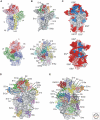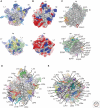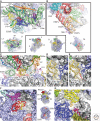The structure and function of the eukaryotic ribosome
- PMID: 22550233
- PMCID: PMC3331703
- DOI: 10.1101/cshperspect.a011536
The structure and function of the eukaryotic ribosome
Abstract
Structures of the bacterial ribosome have provided a framework for understanding universal mechanisms of protein synthesis. However, the eukaryotic ribosome is much larger than it is in bacteria, and its activity is fundamentally different in many key ways. Recent cryo-electron microscopy reconstructions and X-ray crystal structures of eukaryotic ribosomes and ribosomal subunits now provide an unprecedented opportunity to explore mechanisms of eukaryotic translation and its regulation in atomic detail. This review describes the X-ray crystal structures of the Tetrahymena thermophila 40S and 60S subunits and the Saccharomyces cerevisiae 80S ribosome, as well as cryo-electron microscopy reconstructions of translating yeast and plant 80S ribosomes. Mechanistic questions about translation in eukaryotes that will require additional structural insights to be resolved are also presented.
Figures





References
-
- Alkalaeva EZ, Pisarev AV, Frolova LY, Kisselev LL, Pestova TV 2006. In vitro reconstitution of eukaryotic translation reveals cooperativity between release factors eRF1 and eRF3. Cell 125: 1125–1136 - PubMed
-
- Allen GS, Zavialov A, Gursky R, Ehrenberg M, Frank J 2005. The cryo-EM structure of a translation initiation complex from Escherichia coli. Cell 121: 703–712 - PubMed
-
- Andersen GR, Pedersen L, Valente L, Chatterjee I, Kinzy TG, Kjeldgaard M, Nyborg J 2000. Structural basis for nucleotide exchange and competition with tRNA in the yeast elongation factor complex eEF1A:eEF1Bα. Mol Cell 6: 1261–1266 - PubMed
-
- Andersen CB, Becker T, Blau M, Anand M, Halic M, Balar B, Mielke T, Boesen T, Pedersen JS, Spahn CM, et al. 2006. Structure of eEF3 and the mechanism of transfer RNA release from the E-site. Nature 443: 663–668 - PubMed
Publication types
MeSH terms
Substances
Grants and funding
LinkOut - more resources
Full Text Sources
Molecular Biology Databases
